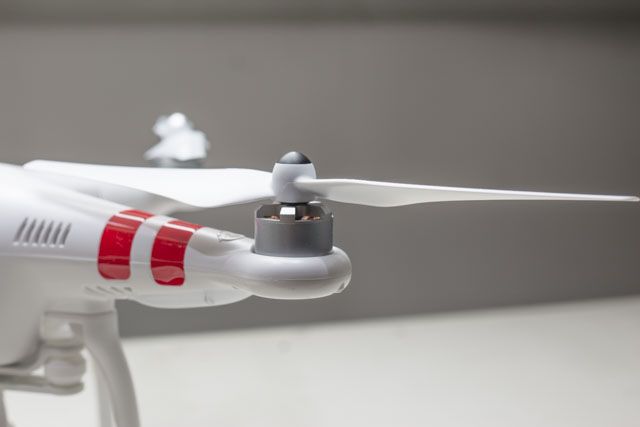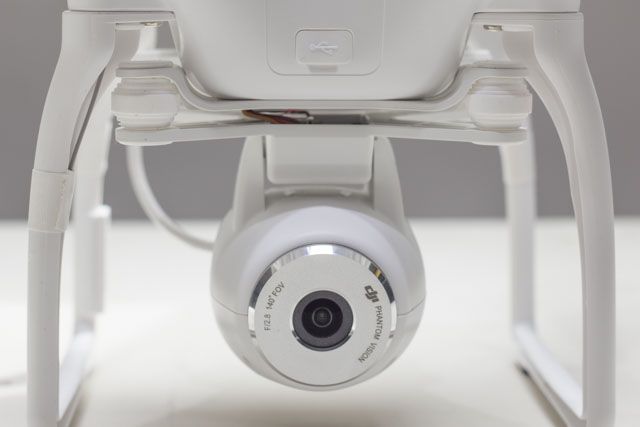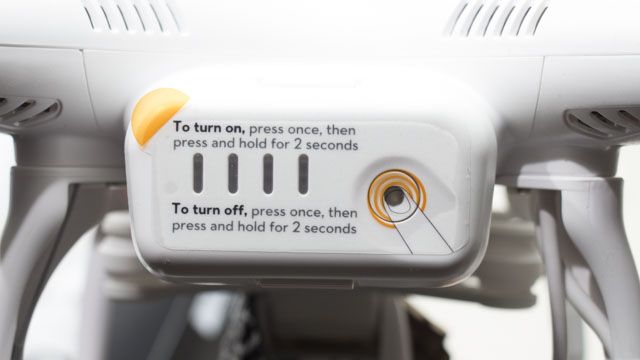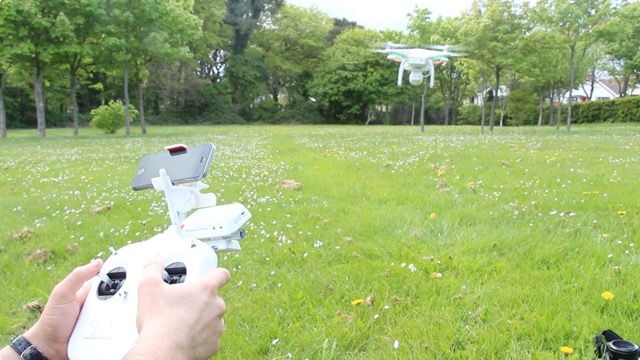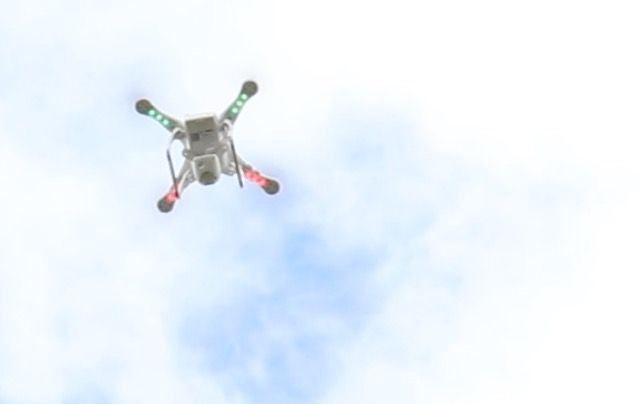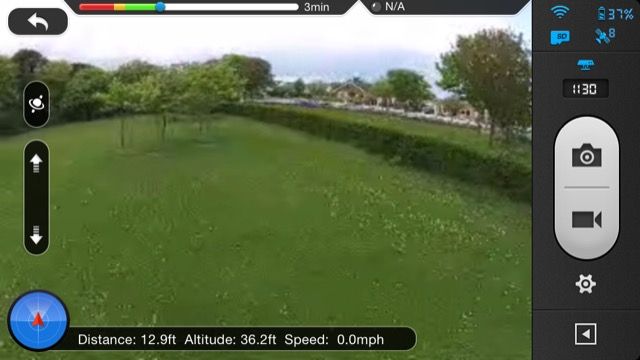DJI Phantom 2 Vision
The DJI Phantom 2 Vision is extremely well built, easy to fly and stays in the air for a decent length of time. It's everything you need in a fun drone.
Over the past few years one company has become synonymous with camera drones: DJI. Any time you see an awesome video shot with a quadcopter, the chances are they used one of the Chinese manufacturer's products.
There are three quadcopters in DJI's popular Phantom 2 line: the Phantom 2, Phantom 2 Vision and Phantom 2 Vision+. The Phantom 2 is the basic model and comes without a camera. It's designed to be used with your own camera — typically a GoPro — and a gimbal, both bought separately. The Vision model comes with a built-in 14MP camera. The Vision+ has the same camera but rather than being mounted directly to the body, it has a three-axis gimbal for more stable footage. We checked out the Phantom 2 Vision which you can pick up on Amazon for $750.
What's in the Box
In the box you get:
- The DJI Phantom 2 Vision
- The remote control
- A smartphone mount
- A battery
- Charger and international cables
- WiFi Range Extender
- 4GB Micro SD
- Spare Rotors
- The manuals and some stickers
Quality Chinese Manufacturing?
Chinese companies don't have the best reputation for making high-quality products so it's great to see that DJI proves to be an exception. The Phantom 2 Vision feels almost Apple-esque in quality. It's extremely solidly build and has a nice weight to it: with the propellers attached and the battery inserted, the whole package weighs 1.16kg. It almost feels too heavy to fly!
The Phantom 2 looks futuristic. The smooth curves of its body, bulbous protruding camera and short angular propellors all combine to create something that wouldn't look out of place in a sci-fi film. This form isn't without function. The smooth curves allow the quadcopter to move easily in any direction once it's airborne, the camera is bulbous to let in more light, and the short propellors are surprisingly powerful.
The remote, similarly, feels great. It's big, comfortable to hold and solidly built without being too heavy. The control sticks move freely with only a small bit of pressure pulling them back towards centre. The three switches have a nice tactile click to them. The remote feels like it could take a beating out on location, though I didn't put that assumption to the test.
Even the peripherals like the battery charger are well made. While this is a minor point, it does show how much thought has gone into the Phantom 2.
Getting Started
Getting started with the Phantom 2 Vision is simple. One of the first things you notice after opening the box is that attached to each component are little tags with instructions. Rather than having to dig through the manual, just handling each component and removing it from the packaging is enough to give you a good idea of what everything does. Combine that with the excellent Quick Start manual, and getting your Phantom flight-ready takes no time.
Flying the DJI Phantom 2
Flying the Phantom 2 is unlike flying cheaper drones. It's bigger, heavier, far more powerful, and has responsive controls. This means you need to use a very fine touch to keep the drone behaving exactly as you want, especially when coming into land. However, the Phantom 2 also has some advanced features which make some aspects of flying much easier.
The drone has automatic stabilisation. As long as you're gentle with the controls you don't have to worry about the Phantom 2 shooting sideways or suddenly dropping out of the sky. If you let go of the controls entirely it's content to hover in place. Similarly, the drone's descent speed is limited to two metres per second. While a crash at that speed can definitely hurt the drone or any nearby people, it's certainly a lot more gentle than a one kilo drone free falling from 1200 feet.
The Phantom 2 also has automated safety features. If it loses connection with the remote it will use its GPS to return to where you launched it from and land itself. Similarly, if the power level drops too low the drone will begin to descend so as to avoid running out of battery and crashing. While the safety features are a positive overall, they certainly aren't without risks: the DJI will just descend into whatever is below. If you're flying over water when the battery runs low or there are any trees near where it considers home, you could be dealing with a suicidal drone.
The Phantom 2's battery life is pretty decent. DJI claims you get 25 minutes on a full charge and while I never exceeded that, flight time never fell below about 20 minutes either. The batteries charged reasonably quickly — it took about two hours for a battery to go from about 20% to 90%. If you're planning to fly for an afternoon, additional batteries will definitely be needed. I imagine three batteries and two chargers would be enough to keep a Phantom 2 in the air for a few hours. Four batteries and three chargers would keep it their almost indefinitely.
While flying the Phantom 2 is far from hard, it's not something I'd recommend to a first time drone user. If you're just starting out, I'd grab something a little cheaper and learn to fly with that before moving on to a DJI.
The Camera
To be honest, I was slightly disappointed with the Phantom 2 Vision's camera. It captures 1080p video at 30 frames per second which is adequate but no more. A Phantom 2 with a recent GoPro attached would have a greater choice of resolutions and frame rates including 4k and slow motion footage.
While the camera has a shock mount to remove the worst of the shake from the drone, without a three axis gimbal you really can't get stable footage unless you're hovering. The footage just didn't have the epic, smooth sweep that's become the trademark of drone videos.
For stills the camera works much better. The 14 megapixel images from the f/2.8 wide angle lens look great and have that drone quality the video is so sorely missing.
If you're planning to use the drone for epic cinematography, then the Vision just isn't going to cut it. The camera from a Vision+, or even a gimbal mounted GoPro, will give much better results. For a fun bit of aerial footage, however, it's fine. Your videos won't be featured on YouTube's homepage but you will be able to get interesting shots from a cool perspective that will make you think about your local area differently.
The DJI Vision App
You need the DJI Vision app to make the most of the Phantom 2. The free app is available for iOS. Connect your smartphone to the drone's WiFi network and you can then view a live feed from the camera. Although the quality of the live stream is quite low, it's more than enough to see what's happening. This makes piloting the drone much easier as you can fly it out of your direct line of sight without fear you'll lose it. It also makes it much easier to shoot video.
The app is used for triggering the camera. If you want to start recording video or take a picture, you have to use the onscreen buttons.
The app also displays status information about the drone. The app shows battery levels, flight time remaining, altitude, distance, speed and more. All this information is critical for properly flying the Phantom 2.
When the drone isn't in the air, the app can be used to pull footage directly from the Phantom 2's SD card or change some of its settings.
The app works as promised and is an important part of the Phantom 2's controls. Running on my iPhone 5S I never encountered any issues. While it's not as intuitive as it could be, it's packed with features and so the complexity is understandable.
What Else Is Out There
In terms of high-end camera drones, the other options are mainly different DJI products. If you're looking for a professional cinematography platform the new DJI Inspire 1 [Broken URL Removed] is expensive but is the best available. If you don't need the full features of an Inspire but want better video than the Vision can offer, the Phantom 3 line [Broken URL Removed] or one of the other Phantom 2's will be a better choice but more expensive.
At the lower end, it's still possible to buy a Phantom 1 [Broken URL Removed] but you lose many of the great features of DJI's later models. There are also products like Parrot's AR Drone 2.0 but again, they are a lesser offering.
Finally, if you're just getting started with drones, the Syma X5C, which I've reviewed previously, is a great, beginner-friendly quadcopter.
Wrapping Up
Overall the DJI Phantom 2 Vision is the best hobbyist drone you can buy. Any of DJI's more expensive offering's are designed as dedicated camera platforms. The Phantom 2 Vision is a drone you can take out and enjoy flying. If you're using the camera mainly for live view so you can control the drone, then it's lack of a gimbal is a moot point. If you're interested in the cinematography side of things the Vision just won't cut it, but compared to everything else out there it's still a marvellous piece of technology.
[recommend]The DJI Phantom 2 Vision is extremely well built, easy to fly and stays in the air for a decent length of time. It's everything you need in a fun drone.[/recommend]
Send your products to be reviewed. Contact James Bruce for further details.

